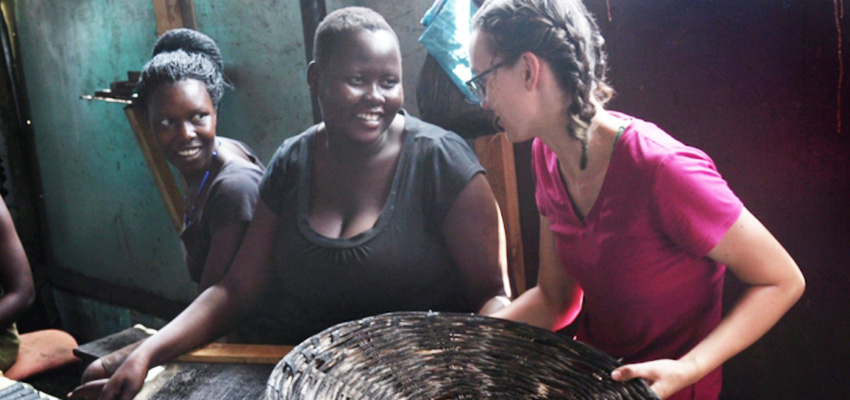
Mechanical engineering students in MIT D-Lab are working with collaborators in Uganda on a solution for the health hazards associated with wood-burning stoves.
For millions of people globally, cooking in their own homes can be detrimental to their health, and sometimes deadly. The World Health Organization estimates that 3.8 million people a year die as a result of the soot and smoke generated in traditional wood-burning cookstoves. Women and children in particular are at risk of pneumonia, stroke, lung cancer, or low birth weight.
“All their life they’re exposed to this smoke,” says Betty Ikalany, founder and chief executive director of Appropriate Energy Saving Technologies (AEST). “Ten thousand women die annually in Uganda because of inhaling smoke from cookstoves.”
Ikalany is working to eliminate the health risks associated with cookstoves in Uganda. In 2012 she met Amy Smith, founding director of MIT D-Lab, who introduced her to D-Lab’s method of manufacturing briquettes that produce no soot and very little smoke. Ikalany saw an opportunity to use this technology in Uganda, and founded AEST that same year. She started assembling a team to produce and distribute the briquettes.
Made of charcoal dust, carbonized agricultural waste such as peanut shells and corn husks, and a cassava-water porridge, which acts as a binding agent, the briquettes are wet initially. To be usable in a cookstove, they must be completely dried. Ikalany’s team dries the briquettes on open-air racks.
In ideal sunny conditions, it takes three days for the briquettes to dry. Inclement weather or humidity can substantially slow down the evaporation needed to dry the briquettes. When it rains, the briquettes are covered with tarps, completely halting the drying process.
“The drying of the briquettes is the bottleneck of the whole process,” says Danielle Gleason, a senior studying mechanical engineering. “In order to scale up production and keep growing as a business, Betty and her team realized that they needed to improve the drying process.”
Gleason was one of several students who were connected to Ikalany through MIT D-Lab courses. While taking the cross-listed MIT D-Lab class 2.651/EC.711 (Introduction to Energy in Global Development) as a sophomore, she worked on a project that sought to optimize the drying process in charcoal briquettes. That summer, she traveled to Uganda to meet with Ikalany’s team along with Daniel Sweeney, a research scientist at MIT D-Lab.
“Drawing upon their strong theoretical foundation and experiences in the lab and the classroom, we want our students to go out into the field and make real things that have a lasting impact,” explains Maria Yang, professor of mechanical engineering and faculty academic director at MIT D-Lab.
During her first trip to Uganda, Gleason focused on information gathering and identifying where there were pain points in the production process of the briquettes.
“I went to Uganda not to present an incredibly complex solution, but simply to learn from our community partners, to share some ideas our team has been working on, and to work directly with those who will be impacted by our designs,” adds Gleason.
Armed with a better understanding of AEST’s production process, Gleason continued to develop ideas for improving the drying process when she returned to MIT last fall. In MIT D-Lab 2.652/EC.712 (Applications of Energy in Global Development), she worked with a team of students on various designs for a new drying system.
“We spent a whole semester figuring out how to improve this airflow and naturally convect the air,” Gleason explains. With sponges acting as stand-ins for the charcoal briquettes, Gleason and her team used heat lamps to replicate the heat and humidity in Uganda. They developed three different designs for tent-like structures that could facilitate drying at all times — even when raining. At the end of the semester, it was time to put these designs to the test.
“You can prototype and test all you want, but until you visit the field and experience the real-world conditions and work with the people who will be using your designs, you never fully understand the problem,” adds Gleason.
Last January, during MIT’s Independent Activity Period, Gleason returned to Uganda to test designs. She and her team found out that their original idea of having a slanted dryer didn’t work in real-world conditions. Outside of the controlled conditions in the lab, their dryers didn’t have enough air flow to speed up the drying process.
They spent several weeks troubleshooting dryer designs with Ikalany and her team. The team ended up designing covered dryers that allowed the briquettes to dry in both sun and rain, increasing the overall throughput.
“We believe that once we are able to scale up what we have learned from Danielle and her team we should be able to produce five times more a day,” says Ikalany. “Our production capacity will increase and the demand for customers will be met.”
In addition to helping Ikalany scale up the production of the potentially life-saving briquettes, Gleason and her fellow students left Uganda with a broadened world view.
“For most students, this is the first time they will visit these countries,” adds Yang. “Not only do we want to benefit our collaborators, we want our students to gain formative and enriching experiences.”
Gleason left Uganda with a deeper appreciation of community. “Seeing how close the community Betty and her team are a part of really made me value the idea of community more,” she recalls.
While other students will pick up where Gleason and her team left off in their work with Ikalany in the coming months, Gleason hopes to continue working on solutions in the developing world as she explores future career paths. “I really love looking at how people interact with the things they use, and I think there’s so much room for growth in user-interfacing in the developing world,” she says.
More information
MIT D-Lab Biomass Fuel and Cookstoves Research
Contact
Dan Sweeney, MIT D-Lab Research Scientist, Biomass Fuel and Cookstoves
Libby Hsu, MIT D-Lab Academic Program Manager

